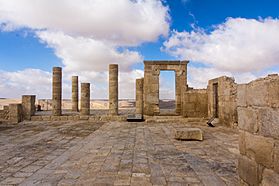Nabataean Kingdom facts for kids
Quick facts for kids
Nabataean Kingdom
𐢕𐢃𐢋𐢈
|
|||||||||||||
|---|---|---|---|---|---|---|---|---|---|---|---|---|---|
| 3rd century BC–106 AD | |||||||||||||
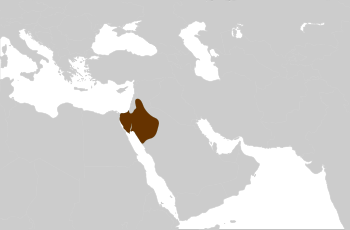
The Nabataean Kingdom at its greatest extent
|
|||||||||||||
| Capital | Petra 30°19′43″N 35°26′31″E / 30.3286°N 35.4419°E |
||||||||||||
| Common languages |
|
||||||||||||
| Religion | Nabataean religion | ||||||||||||
| Government | Monarchy | ||||||||||||
| King | |||||||||||||
| Historical era | Antiquity | ||||||||||||
|
• Established
|
3rd century BC | ||||||||||||
|
• Obodas I repels Hasmonean invasion
|
90 BC | ||||||||||||
|
• Conquered by the Roman Empire
|
106 AD | ||||||||||||
| Currency | Nabataean Denarius | ||||||||||||
|
|||||||||||||
The Nabataean Kingdom (also called Nabatea) was an ancient Arab kingdom. It was ruled by the Nabataeans, a group of Arab people who lived a long time ago.
This kingdom became very rich by controlling important trade routes. They traded goods like spices and perfumes. Their land stretched from the Red Sea coast up to Damascus for a short time.
The Nabataean Kingdom stayed independent for many centuries. It lasted from the 4th century BC until 106 AD. Then, the powerful Roman Empire took control of it. The Romans renamed the area Arabia Petraea.
Contents
History of the Nabataeans
Who Were the Nabataeans?
The Nabataeans were originally Bedouin tribes. These were nomadic groups who moved around the Arabian Desert. They traveled with their animals to find water and good places for grazing.
They learned a lot about their land over time. This helped them survive tough years when there wasn't much rain. At first, they were influenced by Aramaic culture. But experts now agree they were a northern Arabian tribe. This is based on their language, religion, and archaeological finds.
Where Did They Come From?
The exact origin of the Nabataeans is still a bit of a mystery. Some think they came from Yemen in the southwest of the Arabian Peninsula. However, their gods, language, and writing are different from those in southern Arabia.
Another idea is that they came from the eastern coast of the peninsula. A more popular idea suggests they came from the Hejaz area. This is because they shared many gods with the ancient people there. Also, the root of their name, nbtw, is found in early Semitic languages from Hejaz.
There are also links between their language and dialects in Mesopotamia. The Assyrians, an ancient people, even listed a group called "Nabatu" as rebellious Arab tribes. This suggests a connection.
It's thought the Nabataeans might have moved west from Mesopotamia. They settled in northwestern Arabia and what is now Jordan between 600 and 400 BC. They were sometimes confused with other groups, like the "Nabaiti" or the "Nebaioth" from the Hebrew Bible. But these connections are not correct.
Unlike many other Arab tribes, the Nabataeans became very important. They grew rich and powerful. But eventually, their influence faded, and they were largely forgotten for a long time.
How the Kingdom Began

The Nabataeans were good at writing. They left behind thousands of inscriptions, but no long history books. We first see them in historical records around the 4th century BC. However, there's evidence they existed even earlier.
They likely took over the frankincense trade from another group, the Qedarites. This happened after a failed revolt against the Persians around 363 BC. The Persians lost interest in the area, allowing the Nabataeans to become more important. This helped them control the valuable frankincense trade.
The first detailed historical mention of the Nabataeans comes from a Greek historian named Diodorus Siculus. He wrote about them around 30 BC, based on older accounts from Hieronymus of Cardia. Hieronymus was a general under Alexander the Great.
Diodorus described how the Nabataeans survived in the dry desert. They dug hidden water cisterns, known only to them. This allowed them to defeat enemies by waiting until their foes ran out of water. He said they loved their freedom very much.
Diodorus also wrote about attacks by the Greek general Antigonus I Monophthalmus in 312 BC. Antigonus wanted to add the Nabataeans' land to his empire. He sent an officer named Athenaeus to raid them.
Athenaeus attacked a place called "the rock" (which some think was early Petra). He found women, children, and elders there while the men were away trading. The Greeks stole many spices and silver. But the Nabataeans quickly returned with 8,000 soldiers. They attacked Athenaeus's camp and defeated his army.
The Nabataeans then sent a letter to Antigonus. They said they acted in self-defense. Antigonus pretended to agree, but he was planning another attack.
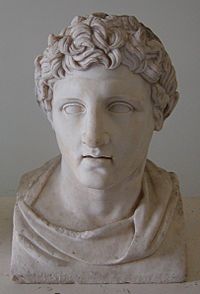
Antigonus's son, Demetrius I of Macedon, led the second attack. The Nabataeans used smoke signals to warn each other. They moved their animals and goods to safe, hard-to-reach places. They also defended "the rock" strongly.
The Nabataeans fought off Demetrius's army. A Nabataean leader told Demetrius that their land was barren and they would not be slaves. Demetrius saw that his army was running out of supplies. He agreed to peace and left.
Antigonus later tried to get valuable bitumen from the Dead Sea. But the Nabataeans, likely on reed rafts, attacked his workers with arrows. This stopped Antigonus from getting rich that way. This event is seen as an early conflict over a Middle Eastern resource.
After Alexander the Great's empire broke apart, the Nabataeans grew stronger. They expanded their kingdom. They even attacked merchant ships from Egypt at one point. This might have been because they felt their trade was threatened.
Building the Nabataean Kingdom

The Nabataean Arabs didn't become a kingdom overnight. It happened in two main stages. The first stage was in the 4th century BC. During this time, they gained more control over trade routes and other tribes. They were present in Transjordan by the end of the 4th century BC. They also moved into the Negev desert. Even without big cities, they showed strong military skills, defending their land against larger powers.
The second stage was around the mid-3rd century BC, when they officially became a kingdom. Having a king is a sign of a developed state. The need to organize trade and wars helped them unite under a king. Early evidence of a Nabataean king comes from an inscription in the Hauran region. It mentions a nameless king from the early 3rd century BC.
More evidence comes from the Milan Papyrus. It describes Arabian cavalry belonging to a Nabataean king in the early 3rd century BC. Also, old Nabataean coins from the late 3rd century BC support this early date. The Greek writer Strabo also said that Nabataean kingship was old and well-run. He described their kingdom as "very well governed" and the king as "a man of the people."
For over 400 years, the Nabataean kingdom was a major power. It controlled a large area both politically and commercially. It is considered the first Arab kingdom in this region. The Nabataeans were important in the early Hellenistic world (the period after Alexander the Great). They were wealthy and respected, even if they didn't build huge monuments right away.
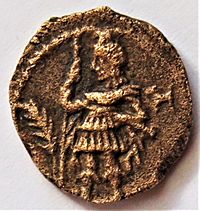
Aretas I is the first Nabataean king we know by name. He is mentioned around 169-168 BC. He was called "the tyrant of the Arabs." A Nabataean inscription in the Negev also mentions a king named Aretas.
Around this time, the Nabataeans had good relations with the Jewish Maccabees. The Maccabees were fighting against the Seleucid Empire. The Nabataeans helped them. The historian Josephus wrote that the Maccabees met the Nabataeans peacefully. The Nabataeans even helped them by storing their supplies during a battle. This shows their strong friendship.
The Nabataeans started making their own coins in the 2nd century BC. This showed how strong and independent their economy and government were. Their capital city, Petra, was listed among the most important cities in the Mediterranean. This shows how significant Nabataea was in the ancient world.
Conflicts with the Hasmoneans
The Nabataeans were allies of the Maccabees against the Seleucids. But later, they became rivals of the Hasmonean dynasty, who were Jewish rulers. This rivalry caused problems that led to the Romans getting involved in Judea.
The city of Gaza was very important for trade. It was the last stop for spices before they were shipped to Europe. This gave the Nabataeans a lot of power over Gaza.
Around 100 BC, the Hasmonean King Alexander Jannaeus attacked Gaza. He said the Gazans had favored the Ptolemies over the Jews. Jannaeus captured Gaza and killed its people.
Jannaeus also took over lands north of Nabataea in Transjordan. These lands were on the trade route to Damascus. This threatened the Nabataeans' trade. So, the Nabataean King, Obodas I, fought back to get these areas.
Obodas defeated Jannaeus in the Battle of Gadara around 93 BC. He ambushed Jannaeus's forces in a steep valley. Jannaeus barely escaped alive.
After this victory, the Nabataeans also faced the Seleucids. The Seleucids were not happy with the Nabataeans' growing power. But the Nabataeans won again. In the Battle of Cana, the Seleucid king Antiochus XII Dionysus was killed fighting the Nabataeans. His army fled and died of hunger in the desert.
After these victories, Obodas became the first Nabataean king to be worshipped as a god by his people. A temple was built in the Negev desert at Avdat to honor him. He was buried there, and inscriptions call him "Obodas the god."
During the rule of Aretas III (87 to 62 BC), the kingdom reached its largest size. But then, a Roman army led by Marcus Aemilius Scaurus defeated them. The Romans even attacked Petra. Eventually, a deal was made. Aretas III paid a tribute (money) to the Roman Republic. In return, the Romans officially recognized his rule.
The Nabataean kingdom slowly found itself surrounded by the growing Roman Empire. Rome conquered Egypt and took over Judea. The Nabataean kingdom managed to stay formally independent. But it became a client kingdom, meaning it was under Rome's influence.
The Roman Takeover
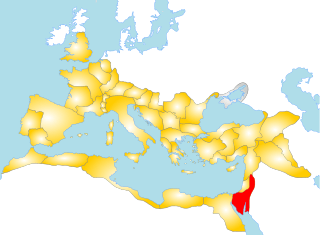
In 106 AD, the last Nabataean king, Rabbel II Soter, died. This likely led to the Roman Empire officially taking over Nabataea. We don't know the exact reasons or how it happened. But some evidence suggests a military campaign led by Aulus Cornelius Palma Frontonianus, the governor of Syria.
Roman forces came from Syria and Egypt. By 107 AD, Roman soldiers were stationed near Petra and Bosra. The kingdom became a Roman province called Arabia Petraea.
Trade continued largely thanks to the Nabataeans' trading skills. Later, under Emperor Hadrian, the Roman border (called the limes Arabicus) was set up. It ran northeast from Aila (modern Aqaba).
About a century later, the Nabataeans stopped making their own coins. They also stopped building their grand tombs. This was likely due to political changes, perhaps an invasion by the new Sassanid Empire from Persia.
The city of Palmyra grew in importance. It took over much of the Arabian trade that used to go through Petra.
Geography of the Kingdom
The Nabataean Kingdom was located between the Arabian and Sinai Peninsulas. To its north was the kingdom of Judea. To its southwest was Ptolemaic Egypt.
Its capital city was Raqmu in Jordan. Other important towns included Bosra, Hegra (Mada'in Saleh), and Nitzana.
Petra, or Raqmu, was a very rich trading city. It was at the meeting point of several important trade routes. One of these was the Incense Route. This route carried myrrh and frankincense from southern Arabia. It passed through Mada'in Saleh to Petra. From Petra, these valuable perfumes were sent all over the Mediterranean region.
See also
 In Spanish: Reino nabateo para niños
In Spanish: Reino nabateo para niños



